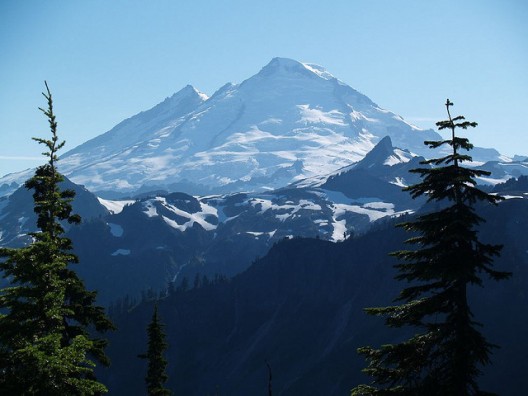
The Obama Administration released the third National Climate Assessment, Climate Change Impacts in the United States, on May 6. Amy Snover, director of the Climate Impacts Group and assistant dean for applied research at the College of the Environment, served as a co-convening lead author of the assessment; additionally, the chapter focused on the Northwest drew heavily from the Climate Impact Group’s body of research, including the 2009 Washington Climate Change Impacts Assessment.
The 841-page report, authored by more than 240 scientific experts from around the country, is a comprehensive synthesis of observed and projected changes in U.S. climate and climate impacts. Information is summarized for the national and regional scale as well as for a range of topics, including water resources, energy supply and use, agriculture, transportation, human health, tribal lands and resources, oceans and marine resources, rural communities, and decision support. The report also assesses progress in response activities such as adaptation and mitigation for the first time.
Download and read the report on the National Climate Assessment website, or read below for key national and regional highlights and links to various resources.
National Highlights
There are many national-scale key findings reported as highlights of the report, which include:
- Global climate is changing. Many independent lines of evidence confirm that human activities are affecting climate in unprecedented ways. U.S. average temperature has increased by 1.3°F to 1.9°F since record keeping began in 1895; most of this increase has occurred since about 1970. Warming is present in all regions of the U.S. but the amount of warming is not uniform because of natural variability.
- Climate will continue to change at an accelerating rate. Temperatures are projected to rise another 2°F to 4°F in most areas of the United States over the next few decades. By end of century, average annual temperature in the U.S. is projected to increase 3°F to 5°F rise under a lower greenhouse gas emissions scenario (the “B1 scenario”) and 5°F to 10°F for a higher emissions scenario (the “A2 scenario”). The largest temperature increases are projected for the upper Midwest and Alaska.
- Climate change affects many components of the built and natural environment. Observed and projected impacts on water quantity and quality, food production, disease vectors, ecosystems, species, infrastructure, sea level, and the marine environment (among others) will affect communities, ecosystem services, biodiversity, and the economy in important ways, as discussed throughout the report.
- Adaptation and mitigation efforts are becoming more widespread. Actions to reduce emissions, increase carbon uptake, adapt to a changing climate, and increase resilience to impacts that are unavoidable can improve public health, economic development, ecosystem protection, and quality of life. While adaptation and mitigation efforts are becoming more widespread, current implementation efforts are insufficient to avoid increasingly negative social, environmental, and economic consequences.
See the Highlights summary and Chapter One (Report Overview and Key Findings) for more summary information.
Highlights from the Pacific Northwest chapter
The Northwest chapter of the National Assessment is a concise summary of the rapidly growing body of research on Northwest climate, climate impacts, and adaptation. Much of the analysis presented in the chapter is structured around the following four key messages:
- Changes in the timing of streamflow related to changing snowmelt are already observed and will continue, reducing the supply of water for many competing demands and causing far-reaching ecological and socioeconomic consequences.
- Threats to infrastructure and habitat, and increasing ocean acidity collectively pose a major threat to the region.
- The combined impacts of increasing wildfire, insect outbreaks, and tree diseases are already causing widespread tree die-off and are virtually certain to cause additional forest mortality by the 2040s and long-term transformation of forest landscapes. Under higher emissions scenarios, extensive conversion of subalpine forests to other forest types is projected by the 2080s.
- While the agriculture sector’s technical ability to adapt to changing conditions can offset some adverse impacts of a changing climate, there remain critical concerns for agriculture with respect to costs of adaptation, development of more climate resilient technologies and management, and availability and timing of water.
Read the Northwest chapter for more information.
For additional information on Northwest climate impacts, you can read:
Climate Change Impacts and Adaptation in Washington State: Technical Summaries for Decision Makers (Snover et al. 2013)
Climate Change in the Northwest: Implications for Our Landscapes, Waters, and Communities (Dalton et al. 2013)
Read more in UW Today, or listen to Amy Snover speak with Steve Scher on KUOW.

